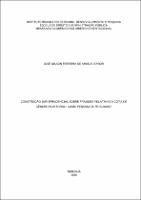Use este identificador para citar ou linkar para este item:
https://repositorio.idp.edu.br//handle/123456789/3350Registro completo de metadados
| Campo DC | Valor | Idioma |
|---|---|---|
| dc.contributor.advisor | Silva, Rafael Silveira e | - |
| dc.contributor.author | Araújo Júnior, Jose Wilson Ferreira de | - |
| dc.date.accessioned | 2021-09-24T12:49:01Z | - |
| dc.date.available | 2021-09-24T12:49:01Z | - |
| dc.date.issued | 2020 | - |
| dc.date.submitted | 2021 | - |
| dc.identifier.citation | ARAÚJO JÚNIOR, Jose Wilson Ferreira de. Construção jurisprudencial sobre fraudes relativas à cota de gênero eleitoral: como pensam os tribunais? 2020. 173 f. Dissertação (Mestrado em Direito Constitucional) - Instituto Brasileiro de Ensino, Desenvolvimento e Pesquisa, Brasília, 2021. | pt_BR |
| dc.identifier.uri | https://repositorio.idp.edu.br//handle/123456789/3350 | - |
| dc.description.abstract | Que tendências interpretativas e avanços relacionados à implementação da cota eleitoral de gênero podem ser extraídos dos julgamentos proferidos pelos tribunais eleitorais nacionais? Como se desenvolveu a jurisprudência dos tribunais eleitorais nacionais, relativamente à exigência da cota eleitoral de gênero, antes e depois da decisão do Supremo Tribunal Federal (STF) na Ação Direta de Inconstitucionalidade (ADI) nº 5.617, que disciplinou regras de julgamento no tema? Partindo de uma visão sobre o comportamento da democracia desde o final do século XX, constata-se que, em dezenas de países da Europa e da América Latina, sinalizam-se tendências de enfraquecimento e até mesmo de colapso de regimes democráticos, em razão de processos de subversão e motivos endógenos. Nesse contexto, traz-se à reflexão até que ponto a ausência ou a insignificante participação da mulher na estrutura do poder político pode contribuir para esse fenômeno. Além disso, tem-se uma estreita correlação dessa reserva com o sistema eleitoral proporcional, perpassando pela tipologia e por um breve contexto histórico e político no qual se desenvolveu a política de cotas de gênero, especialmente no Brasil, com destaque para o período compreendido entre a última leitura cogente dessa regra até a manifestação do STF na ADI nº 5.617. Destaca-se que, num ambiente dominado por produções femininas, a abordagem dessa temática tão propalada no meio acadêmico buscou não incorrer no pecado do argumento retórico, já que o escopo do trabalho, para além da pesquisa teórico-bibliográfica relacionada às premissas doutrinárias que tratam da interligação da referida ação afirmativa com a jurisdição constitucional na discussão de direitos fundamentais — a partir da análise da citada ADI julgada pelo STF, mais precisamente sob o enfoque da diversidade de gênero e do princípio da igualdade —, é buscar, na jurisprudência dos tribunais regionais eleitorais e do Tribunal Superior Eleitoral (TSE), acórdãos que discutam a cota de gênero e a consequente fraude nos registros de candidatura, sob enfoques tanto quantitativos quanto qualitativos, tendo por escopo cotejá-los com a regra de julgamento adotada pela Suprema Corte e, assim, responder às questões inicialmente propostas. | pt_BR |
| dc.description.abstract | What interpretative trends and advances related to the implementation of the gender quota can be extracted from the trials handed down by national electoral courts? How did the jurisprudence of the national electoral courts develop, regarding the requirement of the gender electoral quota, before and after the decision of the STF in ADI nº 5.617, which disciplined rules of judgment in this subject? Starting from a view on the behavior of democracy since the end of the 20th century, it can be seen that in dozens of countries in Europe and Latin America there are signs of weakening and even the collapse of democratic regimes, due to processes of subversion and for endogenous motives. In this context, the question is raised to what extent the absence or insignificant participation of women in the structure of political power can contribute to this phenomenon. In addition, there is a close correlation of this reserve with the proportional electoral system, going through the typology and a brief historical and political context in which the gender quota policy was developed, especially in Brazil, with emphasis on the period between last cogent reading of this rule until the expression of the STF in ADI nº 5.617. It is noteworthy that, in an environment dominated by female productions, the approach of this theme so propagated in the academic environment tried not to incur the sin of the rhetorical argument, since the scope of the work, in addition to the theoretical-bibliographical research related to the doctrinal premises that deal with the interconnection of said affirmative action with constitutional jurisdiction in the discussion of fundamental rights — based on the analysis of the aforementioned ADI judged by the Supreme Federal Court, more precisely under the focus of gender diversity and the principle of equality —, it was sought in the jurisprudence of the TREs and TSE judgments that discuss the gender quota and the consequent fraud in the application records under both quantitative and qualitative approaches, aiming to compare them with the judgment rule adopted by the Supreme Court and, thus, answer the questions initially proposed . | pt_BR |
| dc.language.iso | por | pt_BR |
| dc.publisher | IDP/ EAB | pt_BR |
| dc.rights | Open Access | pt_BR |
| dc.subject | Cotas de gênero | pt_BR |
| dc.subject | Eleições | pt_BR |
| dc.subject | Democracia | pt_BR |
| dc.subject | Princípio da igualdade | pt_BR |
| dc.subject | Jurisdição constitucional | pt_BR |
| dc.subject | Jurisprudência | pt_BR |
| dc.title | Construção jurisprudencial sobre fraudes relativas à cota de gênero eleitoral: como pensam os tribunais? | pt_BR |
| dc.type | Tese de mestrado | pt_BR |
| dc.location.country | BRA | pt_BR |
| Aparece nas coleções: | Mestrado Interinstitucional em Direito (Minter) | |
Arquivos associados a este item:
| Arquivo | Descrição | Tamanho | Formato | |
|---|---|---|---|---|
| DISSERTAÇÃO_ JOSE WILSON FERREIRA DE ARAUJO JUNIOR _MESTRADO EM DIREITO.pdf | 1.32 MB | Adobe PDF |  Visualizar/Abrir |
Os itens no repositório estão protegidos por copyright, com todos os direitos reservados, salvo quando é indicado o contrário.
